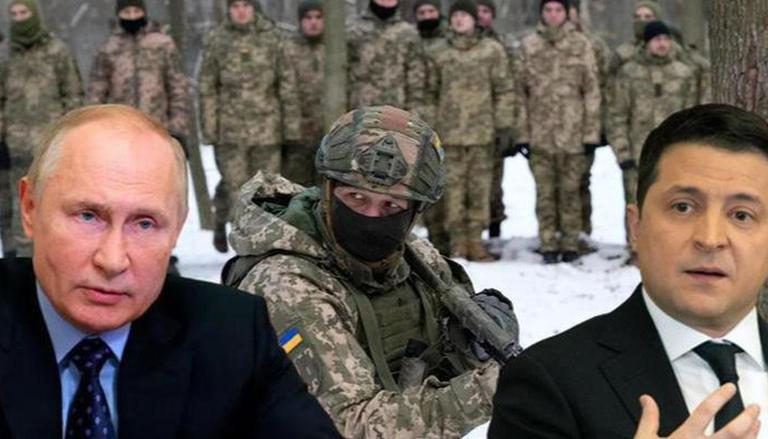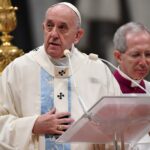On February 24, 2022, exactly 100 days ago, Russia launched offensives on Ukraine over the latter’s attempt to join the North Atlantic Treaty Organisation (NATO).
Russia’s action then triggered global condemnation and chains of reactions from the international community, especially from the West.
- Court remands Osinachi’s husband in Kuje prison over singer’s death
- FCT votes N1bn for Nat Mosque, Christian Center renovation
Since the invasion started, millions of Ukrainians have fled their country to seek refuge in other countries, while Russia continues to launch attacks on Ukraine on land, air and sea.
United Nations Refugees Agency has estimated that since the war started, no fewer than seven million Ukrainians have left the country, while the West keep responding with unprecedented sanctions.
NATO has also since expanded with membership applications from Sweden and Finland, despite Russia’s warnings against the moves.
According to Ukraine President, Volodymyr Zolenskyy, as of June 2, 2022, about 20 per cent of the country is under Russian control.
As the invasion marks the 100th day, Daily Trust reviews the timeline of some major happenings in the war.
February 21: Russian President Vladimir Putin orders troops into the regions of Luhansk and Donetsk, and recognises them as independent states.
February 22: The Russian parliament authorises Putin to use military force. The United States placed full blocking sanctions on the Kremlin-controlled VEB bank and PSB bank. Germany immediately halted the process of certifying the Nord Stream 2 pipeline.
February 23: The European Union froze the assets of 351 Duma members.
February 24: Russia launched a full-scale assault on Ukraine. Ukrainian President Volodymyr Zelenskyy ordered a general mobilisation. The US barred five more Russian banks from the US financial system and froze four of the banks’ US-held assets.
February 25: Russia vetoed a United Nations Security Council resolution demanding that it unconditionally pull its troops out of Ukraine.
February 26: The EU said it will bar selected Russian banks from the Society for Worldwide Interbank Financial Telecommunication (SWIFT) system, essentially cutting them off from the global financial system.
February 27: Russian troops pressed towards three cities, Kyiv, Kharkiv and Kherson. European Commission President Ursula von der Leyen said Russian civilian aircraft are banned from EU airspace, and Russian state-owned media Russia Today, Sputnik and their subsidiaries are banned from EU airwaves and the internet.
February 28: The EU approves a €500 million ($537m) support package for the Ukrainian military. “This is the first time in history that the EU will be providing lethal equipment to a third country,” the EU’s foreign policy chief Josep Borrell said. Total EU aid has since risen to 4.5bn euros ($4.8bn). Ukraine applied to join the EU, which bans transactions with Russia’s central bank. The Russian rouble tumbles 30 per cent.
March 1: In a new offensive, a Russian convoy 65km long heads for Kyiv.
March 2: Russian tanks entered Kherson, making the southern Ukrainian town the first major population centre (250,000 people) to fall. Russian forces surround Mariupol.
March 8: The European Commission unveiled REPowerEU, a plan to reduce dependence on Russian natural gas by two-thirds by the end of the year, surpassing in ambition the plan unveiled on March 3 by the International Energy Agency (IEA). The US imposed a ban on Russian crude oil imports.
March 9: Russian air strikes target a maternity hospital in the besieged city of Mariupol.
March 10: The US Congress approved $13.6bn in spending for Ukraine.
March 11: The EU issued the Versailles Declaration, calling on member states to strengthen defence spending, investment, research and coordination. The US led a new round of sanctions against Russia backed by the Group of Seven (G7) bloc of nations.
March 16: Hundreds died when Russian troops bomb the Mariupol theatre, as civilians sheltered inside. Fighting reached the city centre.
March 23: NATO estimates that Russia has lost 7,000-15,000 soldiers. The administration of US President Joe Biden formally determined that Russia has committed war crimes in Ukraine. Putin said future gas sales to “unfriendly” countries – corresponding to the US, European Union members, the United Kingdom and Japan – will be denominated in roubles rather than US dollars.
March 24: On a trip to Europe, Biden pledged to provide Europe with 15 billion cubic metres (bcm) more natural gas than last year, bringing shipments to Europe to 37bcm this year. It pledged an additional 50bcm by 2030.
March 25: Russia said it would focus on consolidating its control over the eastern Ukrainian provinces of Luhansk and Donetsk and started to withdraw troops from Kyiv.
March 26: During a visit to US troops in Poland, Biden appeared to suggest regime change in Moscow. “For God’s sake, this man cannot remain in power,” Biden said of Putin. Biden backpedalled on the remark the following day.
March 29: Russian and Ukrainian negotiators met in Istanbul. Ukraine put forward a detailed proposal of neutrality.
April 1: An Al Jazeera report revealed that Russia was using proxy groups in Syria to recruit fighters for Ukraine.
April 2: As Russian troops withdrew from Bucha, a town northwest of Kyiv, dozens of corpses in civilian clothes were found on the streets.
April 7: Ukrainian authorities said Russia fired a cluster munition into a railway station packed with thousands of evacuees, killing at least 52. The attack took place in the city of Kramatorsk in the eastern Donetsk region.
April 8: The EU banned imports of Russian coal, lumber, cement, seafood and fertilisers.
April 10: Russian forces bisected Mariupol.
April 14: Ukraine said it had sunk the Russian Black Sea Fleet flagship Moskva with two Neptune missiles.
April 18: Russian forces launched a new, large-scale offensive in East Ukraine to take full control of the Luhansk and Donetsk oblasts.
April 20: The International Monetary Fund forecasted global growth of 3.6 per cent this year and next, a downward revision of 0.8 per cent for this year and 0.2 per cent for next year compared to January forecasts, owing to the war in Ukraine.
April 21: Putin declared victory in Mariupol, though 2,500 Ukrainian defenders in the Azovstal steelworks have not surrendered.
April 26: Austin pressed delegates from 40 nations to contribute more weapons as soon as possible to Ukraine’s war effort at a military donors’ conference at Ramstein air base in Germany.
April 27: Russia cut off gas flows to Bulgaria and Poland, allegedly for refusing to pay for gas in roubles.
April 28: The US Congress revived World War II-era “lend-lease” facilities to speed up weapons shipments to Ukraine. Biden asked Congress to approve a $33bn spending package for Ukraine.
May 2: Germany said it was willing to ban Russian oil immediately, in a change of position.
May 3: In a speech to the European Parliament, Italian prime minister Mario Draghi called for a “pragmatic federalism” in which majorities of member states can override vetoes to collective action – a clear hint toward Hungary and Slovakia, which are blocking an EU ban of Russian oil and gas.
May 4: A Ukrainian counteroffensive north and east of Kharkiv had pushed Russian troops 40km back from the city, in the first major Ukrainian success since winning the battle for Kyiv.
May 9: French President Emmanuel Macron supported creating a strengthened form of association with the EU that would enable Ukraine and other EU hopefuls such as Moldova and Georgia to enjoy many aspects of membership quickly.
May 11: Ukrainian Deputy Prime Minister Iryna Vereshchuk said Russia has deported some 460,000 Ukrainians to 6,500 camps across Russia. Ukraine for the first time limited Russian gas transiting its territory to Europe, cutting by one-quarter the flow of gas through one of two major pipelines.
May 12: Finland announced it would seek NATO membership.
May 15: Sweden announced it would apply for NATO membership, ending two centuries of neutrality.
May 17: Ukraine’s military declared an end to the Azovstal operation in Mariupol. Russia’s defence ministry confirmed that 265 Ukrainians have surrendered.
May 18: The European Commission announced a 220 billion euro ($236bn) plan to ditch Russian fossil fuels over five years.
May 19: The US approved $40bn in new spending for Ukraine, half of its military investment.
May 20: Former German Chancellor Gerhard Schroeder bowed to pressure to resign his seat on the board of Russian oil giant Rosneft.
May 21: Russia said it had full control of Mariupol, after almost 2,500 Ukrainian troops surrendered.
May 23: Ukraine sentenced the first Russian soldier convicted of war crimes to life in prison.
May 25: Eduard Basurin, deputy head of the militia of the Russia-backed Donetsk People’s Republic, said Russia was abandoning the larger strategy of surrounding all of Ukraine’s forces in the east with a grand pincer movement, instead of focusing on piecemeal isolations.
Zelenskyy blasted former US Secretary of State Henry Kissinger for suggesting that Ukraine surrender land to Russia. He likened it to the policy of appeasement in the 1930s.
May 26: Russian forces continued a slow encirclement of Severdonetsk, and are reportedly in possession of the northeastern portion of the city. Ukrainian Deputy Defence Minister Anna Malyar said “fighting has reached its maximum intensity. The enemy is storming the positions of our troops in several directions simultaneously”.
May 27: Russian forces advanced on Severdonetsk from three different directions, and began direct assaults on built-up areas of the city in the north, taking control of the Mir hotel.
May 28: Ukraine launched a counteroffensive in Kherson, reportedly bringing Russian forces to a “disadvantageous” defensive position and inflicting heavy losses.
In telephone calls with the leaders of France and Germany, Putin offered to facilitate Ukrainian grain exports in return for an easing of sanctions against Russia.
May 30: After some hesitation, Biden decided to send “more advanced rocket systems” to Ukraine to enable greater precision artillery strikes. The US will send guided multiple launch rocket systems (GMLRS) and high mobility artillery rocket systems (HIMARS) to add firepower to Ukraine’s defences.
May 31: Russian forces occupied the centre of Severdonetsk as Ukrainian troops made a tactical retreat. Fighting raged in the town of Toshkivka, south of Severdonetsk, as Russian forces attempted to complete an encirclement of Severdonetsk from the south.
In the south, Ukrainian forces pressed a counteroffensive towards Kherson, pushing Russian forces east of the Inhulets River.
The EU banned Russian oil and petroleum products, following a decision on the sixth package of sanctions against Russia. A temporary exception is made for pipeline oil, after the objections of landlocked countries that they could not easily supply themselves by sea.
June 1: Russian troops held the city centre of Severdonetsk and, according to estimates, up to 70 per cent of the city.
Germany promised to send Ukraine the IRIS-T, the most modern artillery and targeting system it possesses. The system will come with radar that helps target enemy artillery.
(Aljazeera)

 Join Daily Trust WhatsApp Community For Quick Access To News and Happenings Around You.
Join Daily Trust WhatsApp Community For Quick Access To News and Happenings Around You.

